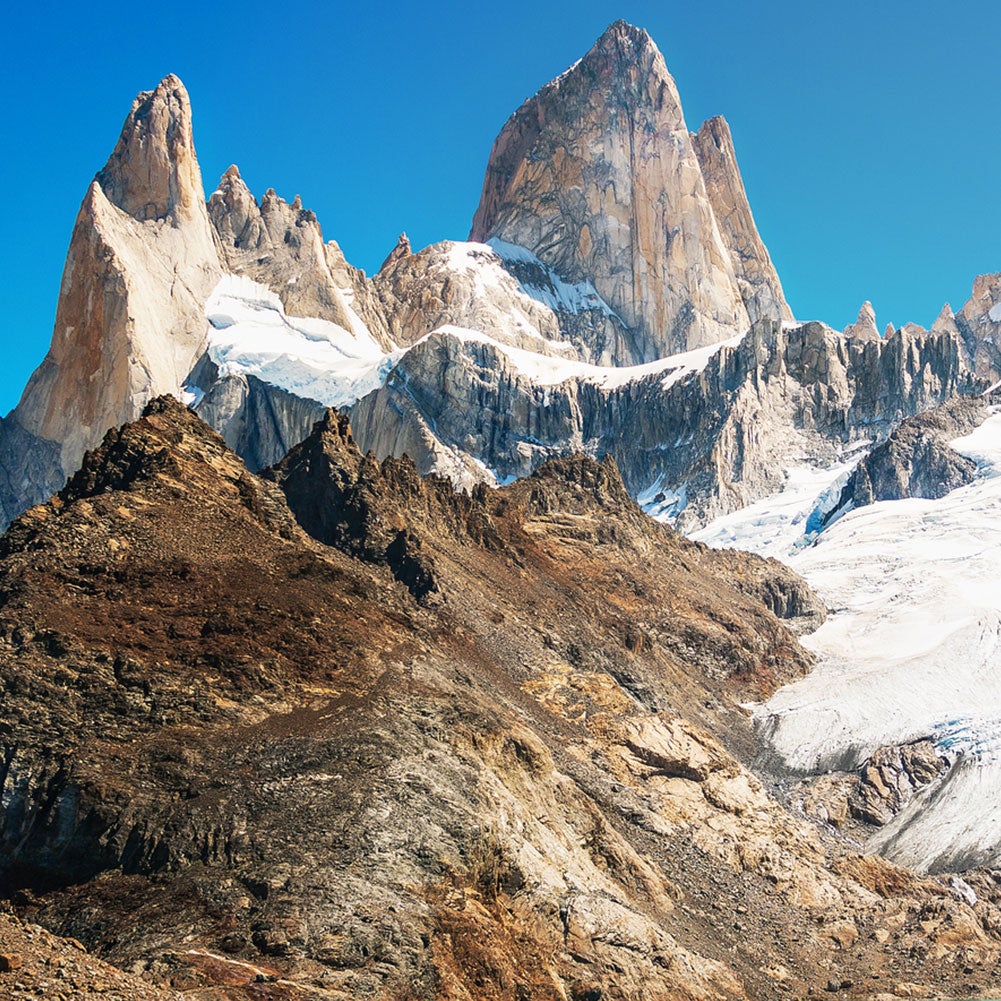This article was first published by .
On January 19, Basque climbers Amaia Agirre, 31, and Iker Bilbao, 29, were killed while descending 11,171-foot Fitz Roy in Patagonia when a large, wet avalanche swept them into a crevasse. They had successfully climbed the 5,000-foot route and had rappelled La Brecha de los Italianos—a gully notorious for its falling rock, ice, and snow—before pausing on the glacier below to reorder their equipment. It was during this break that an avalanche released from the steep snow slopes below La Brecha, dragging Agirre and Bilbao into the crevasse. The third member of their party, Josu Linaza, ran perpendicular to the avalanche’s path and was not buried. Due to the high avalanche danger and the loss of the ropes, Linaza did not attempt to dig them out.
Linaza hiked for four hours before reaching a group of climbers who could call for a rescue. The message was sent to the unofficial rescue team of the area, the El Chaltén Alpine Rescue Centre, of which Dr. Carolina Codó is the leader. The team met to discuss the situation, aware that they were at least six hours from the accident site, and that the chances of survival while being buried in an avalanche would drop dramatically over time.
“Death by suffocation and hypothermia is inevitable,” Codó wrote to Climbing in an email (translated from Spanish). “Therefore, we evaluated that the [rescue team] volunteers could not be risked when the chances of survival were zero.”
Professional climber Jacob Cook was bivvied on the summit of Cerro Chaltén when he received news of the accident. The following morning, Cook and his partners descended the route Franco-Argentina and then waited all day above La Brecha for its sun-baked walls to go into the shade, providing safer conditions to descend. Cook feared for wet avalanches, like the one that took Agirre and Bilbao, as well as for La Brecha itself.
View this post on Instagram
La Brecha used to be a gully filled with low-angle ice which held together loose rock. Now, rising temperatures have all but erased the ancient ice and have left a dangerous shooting gallery in its wake. Cook described several climbers who have had close calls in the gully recently: a friend’s leg was broken by a falling rock, and another friend had refrigerator-sized blocks fly past him while rappelling. And in February 2022, was killed by rockfall while rappelling La Brecha.
When Cook reached La Brecha’s accident scene roughly 33 hours after the avalanche, he was struck by how unfortunate Agirre and Bilbao had been. “It’s a very dangerous place but they were also extremely unlucky to be where they were when that happened,” Cook said. “It seems unbelievably unlucky, like they could have been five meters to the left and probably survived.”
Cook blames climate change for Fitz Roy–and other Patagonian mountains—becoming more hazardous in recent years: high day-time temperatures can produce destructive wet avalanches and cause loose blocks to effectively unfreeze from alpine walls. Climbing Fitz Roy has become especially dangerous, Cook said, because La Brecha is still the best way off the peak. “There just isn’t a good descent from the mountain right now,” he said. “It’s definitely a problem facing [climbers] in El Chaltén.”
Other options include descending the North (Goretta) Pillar via the Casarotto route, which is unappealing for climbers who’ve summited via the Afanassieff as they will be rappelling more steep, technical terrain than the Franco-Argentina/La Brecha descent. There is also the descent, but Cook does not recommend it for its similarly serious nature: it’s the biggest face on Fitz Roy at 3,000 feet. “Especially onsight, you’d be rapping into an extremely committing situation,” he said.
View this post on Instagram
Eneko Pou, a frequent Patagonia climber and friend of Agirre, said Agirre and Bilbao were talented young alpinists with promising futures. Pou did not know Bilbao personally, but knew he was a well-respected alpinist and a career firefighter. According to Pou, Agirre was one of the strongest alpinists in Spain and had “a lot of talent doing almost everything, a lot of specialties.” She’d climbed 5.12+ and WI 6, and went on several expeditions, including Nepal in 2021, where she participated as a medic on a new route up Chekigo’s south face. Agirre also did the first female ascent of Groucho Marx in Chamonix and was a member of the National Women’s Mountaineering Team of the Spanish Federation of Mountain Sports and Climbing.


